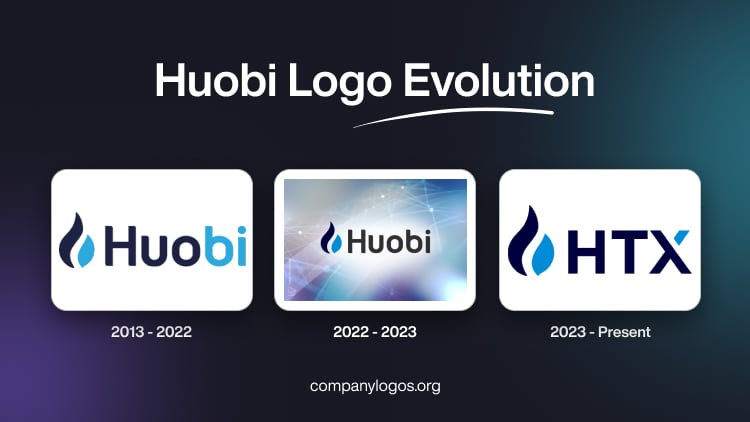
Huobi is a leading global cryptocurrency exchange and blockchain service provider that was founded in 2013 by Leon Li in China. It was initially launched as a Bitcoin trading platform and then quickly expanded to offer a wide range of digital asset services. These included spot trading, derivatives, staking, and blockchain-based financial solutions. Over the years, Huobi has grown into one of the world’s most recognised crypto brands, and it serves millions of users across multiple regions.
Besides, Huobi is known for its innovative approach, robust security measures, and a commitment to regulatory compliance. It has played a key role in shaping the global cryptocurrency ecosystem. The article explores the evolution of the Huobi logo, among other details of the company.
The Genesis of the Huobi Logo (2013 – 2022)
The original logo consisted of a flame motif in dark navy blue and vibrant blue symbolising “fire currency” and the wordmark “Huobi” or “Huobi Global” in a title case. Interestingly, the first three letters of the “Huobi” wordmark were shown in dark navy blue, while the last two were shown in vibrant blue. However, “Global” was shown in dark navy blue only. The twin-colour style of the “Huobi” wordmark resembled the colour style of the flame motif. The stylised flame motif looked like twin droplets in dark navy blue and vibrant blue.

(2022 – 2023)
The year 2022 saw the rebranding of the company, wherein it came to be known as “Huobi” instead of “Huobi Global”. The flame motif in a dark navy blue and vibrant blue colour palette appeared to the left of the brand name in a rounded, geometric sans-serif typeface in dark navy blue.

(2023 – Present)
The company was rebranded again in September 2023, when it came to be known as “HTX”, or the “Huobi Tron Exchange”. Here, the flame motif was accompanied by the wordmark “HTX” in a rounded sans-serif typeface. The top right section of the letter “X” is depicted in vibrant blue.

The Elements of the Huobi Logo
Font
The Huobi wordmark is written using a rounded sans-serif typeface. It is designed to look contemporary, smooth, and highly legible across digital platforms. The uppercase letterforms in “HTX” give the brand a friendly and accessible tone. At the same time, the rounded terminals and balanced spacing suggest openness and modernity.
Colour
The Huobi logo’s colour palette consists of deep navy blue and vibrant sky blue colours. Here, deep navy blue represents trust, stability, and strength, and it symbolises Huobi’s reliability as a financial institution. The vibrant sky blue colour represents innovation, technology, and forward motion. Besides, it reflects the brand’s dynamic energy and focus on progress.
The History of Huobi
Huobi was founded in 2013 by Leon Li in Beijing, China, during the initial phase of Bitcoin adoption. Initially, the platform focused on providing a reliable and secure marketplace for Bitcoin trading. Its Chinese name, Huobi, literally translates to “fire currency”, which inspired the company’s iconic flame logo. From the outset, Huobi emphasised security, user experience, and regulatory compliance, helping it gain early trust among Chinese cryptocurrency traders.
As Bitcoin and other cryptocurrencies gained popularity, Huobi expanded rapidly. By 2014, the platform was processing billions of dollars in transactions and had become one of the largest crypto exchanges in China. During this period, Huobi diversified its services to include trading of multiple cryptocurrencies, OTC services, and digital asset management tools. The company also started exploring international expansion, laying the groundwork for future global operations.
In response to increasing regulatory scrutiny in China, Huobi pivoted toward international markets. In 2017, Huobi Global was launched, marking the company’s focus on serving users outside China. This period saw a major professionalisation of its operations, a refreshed visual identity, and the introduction of a modern two-tone flame logo alongside a friendly, rounded wordmark. Huobi Global expanded its services to include spot trading, derivatives, staking, lending, and other blockchain-based financial products.
In November 2022, Huobi announced a brand refresh following changes in ownership and regulatory strategy. The update clarified the company’s global identity, standardised its logo usage, and strengthened its presence in international markets while maintaining its recognisable flame symbol.
In September 2023, Huobi Global underwent a formal rebrand to HTX, signalling a new era for the exchange under its new corporate structure. The HTX brand replaced Huobi as the official global name, while the traditional flame motif remained in use for legacy assets, token icons, and certain product lines. This rebrand was part of a broader strategy to consolidate the exchange’s global operations and maintain regulatory compliance across different jurisdictions.
Throughout its history, Huobi has been a pioneer in the cryptocurrency exchange space. From its roots as a China-based Bitcoin trading platform to its global expansion and eventual rebrand as HTX, the company has consistently emphasised security, innovation, and user trust. The flame logo, symbolising energy and dynamism, remains one of the most recognisable icons in the crypto industry, reflecting Huobi’s lasting impact on the global digital asset ecosystem.
Interesting Facts About Huobi
- The name Huobi comes from the Chinese words “火币”, which literally translate to “fire currency”. This reflects the company’s energy-driven vision as well as its flame-inspired logo.
- Huobi’s founder, Leon Li, was a computer engineer at Oracle before launching the exchange in 2013. His technical expertise helped build Huobi’s strong and secure trading infrastructure.
- Before China’s crypto trading ban in 2017, Huobi was one of the largest cryptocurrency exchanges in the country. It handled a major share of China’s Bitcoin trading volume.
- When China restricted crypto exchanges in 2017, Huobi swiftly moved its headquarters overseas. It transformed into Huobi Global and focused on international users.
- In 2018, Huobi launched its own utility token, HT. The token gives users trading fee discounts, access to special events, and participation in governance within the Huobi ecosystem.
- In September 2023, Huobi was officially rebranded to HTX, which also marked its 10th anniversary. The name “HTX” represents Huobi Token (HT) + Exchange (X). It also signifies Huobi’s 10-year milestone (X = 10 in Roman numerals).
- Huobi was among the first exchanges to introduce a cryptocurrency market index, which allowed users to track performance across a basket of top digital assets.
- Beyond exchange services, Huobi has expanded into blockchain development, DeFi, and Web3 ventures. These include its blockchain, the HECO Chain (Huobi ECO Chain).
- Huobi is known for its security-first approach. It stores a large portion of user funds in cold wallets and has one of the industry’s best track records for avoiding major breaches.
- Over the years, Huobi (now HTX) has served millions of users across more than 100 countries. It has offices and compliance operations in regions such as Singapore, Seychelles, Japan, and South Korea.
Finally
The evolution of the Huobi logo reflects the brand’s transformation from a domestic cryptocurrency exchange in China to a globally recognised digital asset powerhouse. The logo has remained the defining symbol of Huobi’s identity, and it represents energy, innovation, and the unstoppable growth of blockchain technology.